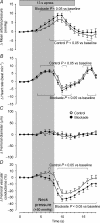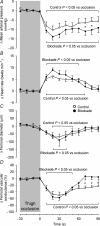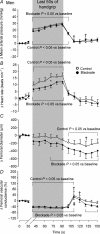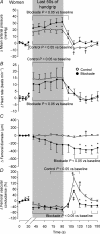Effect of propranolol on sympathetically mediated leg vasoconstriction in humans
- PMID: 17627989
- PMCID: PMC2277027
- DOI: 10.1113/jphysiol.2007.137422
Effect of propranolol on sympathetically mediated leg vasoconstriction in humans
Abstract
Sympatho-excitatory manoeuvres are used to study vascular responsiveness in humans, but it is unclear if circulating adrenaline attenuates peripheral vasoconstriction during these manoeuvres. We hypothesized that vasoconstrictor responses to three manoeuvres (neck pressure, unilateral thigh-cuff release and isometric handgrip) would be greater after the administration of the beta-adrenergic blocker propranolol. Seven men and six women underwent these manoeuvres while beat-by-beat arterial pressure (finger photoplethysmography), femoral mean blood velocity (Doppler ultrasound) and femoral artery diameter (edge-detection software) were measured. Femoral vascular conductance was calculated as flow/pressure. Propranolol had no effect on baseline femoral vascular conductance (P > 0.05). As a result of neck pressure, femoral vascular conductance was reduced 23.9 +/- 3.5% before vs. 33.2 +/- 3.2% after infusion of propranolol (P = 0.033). After thigh-cuff release, femoral vascular conductance declined 50.2 +/- 5.8% before vs. 57.4 +/- 9.6% after propranolol infusion (P = 0.496). During handgrip, femoral vascular conductance was reduced 47.2 +/- 9.6% before vs. 55.2 +/- 9.2% after propranolol administration (P = 0.447). After handgrip, women had a greater rise in conductance than men (women: 153 +/- 16.2%; men: 36.4 +/- 10.6%; P < 0.001), which was blunted by 54.8% by propranolol (P < 0.001 vs. control), but unaffected by propranolol in men (P = 0.355 vs. control). The finding that beta-adrenergic receptor-mediated vasodilatation minimally affects vascular responses to these sympatho-excitatory manoeuvres reinforces their utility in the investigation of sympathetic vascular regulation in humans. Interestingly, post-handgrip hyperaemia is greater in women than men and is, in part, beta-adrenergic receptor mediated.
Figures







Similar articles
-
Ageing and leg postjunctional alpha-adrenergic vasoconstrictor responsiveness in healthy men.J Physiol. 2007 Jul 1;582(Pt 1):63-71. doi: 10.1113/jphysiol.2007.130591. Epub 2007 Apr 26. J Physiol. 2007. PMID: 17463044 Free PMC article.
-
Sympathetic Vasoconstrictor Responsiveness of the Leg Vasculature During Experimental Endotoxemia and Hypoxia in Humans.Crit Care Med. 2016 Apr;44(4):755-63. doi: 10.1097/CCM.0000000000001486. Crit Care Med. 2016. PMID: 26588830
-
Beta-1 vs. beta-2 adrenergic control of coronary blood flow during isometric handgrip exercise in humans.J Appl Physiol (1985). 2017 Aug 1;123(2):337-343. doi: 10.1152/japplphysiol.00106.2017. Epub 2017 Jun 1. J Appl Physiol (1985). 2017. PMID: 28572492 Free PMC article. Clinical Trial.
-
Sex, ageing and resting blood pressure: gaining insights from the integrated balance of neural and haemodynamic factors.J Physiol. 2012 May 1;590(9):2069-79. doi: 10.1113/jphysiol.2011.224642. Epub 2012 Feb 20. J Physiol. 2012. PMID: 22351633 Free PMC article. Review.
-
Respiratory modulation of peripheral vasoconstriction: a modeling perspective.J Appl Physiol (1985). 2019 Nov 1;127(5):1177-1186. doi: 10.1152/japplphysiol.00111.2019. Epub 2019 May 16. J Appl Physiol (1985). 2019. PMID: 31095465 Review.
Cited by
-
Influence of spontaneously occurring bursts of muscle sympathetic nerve activity on conduit artery diameter.Am J Physiol Heart Circ Physiol. 2013 Sep 15;305(6):H867-74. doi: 10.1152/ajpheart.00372.2013. Epub 2013 Jul 5. Am J Physiol Heart Circ Physiol. 2013. PMID: 23832696 Free PMC article.
-
Neurovascular control following small muscle-mass exercise in humans.Physiol Rep. 2015 Feb 3;3(2):e12289. doi: 10.14814/phy2.12289. Print 2015 Feb 1. Physiol Rep. 2015. PMID: 25649250 Free PMC article.
-
Additive influence of exercise pressor reflex activation on Valsalva responses in white and black adults.Eur J Appl Physiol. 2023 Oct;123(10):2259-2270. doi: 10.1007/s00421-023-05240-1. Epub 2023 Jun 3. Eur J Appl Physiol. 2023. PMID: 37269380
-
Spontaneous bursts of muscle sympathetic nerve activity decrease leg vascular conductance in resting humans.Am J Physiol Heart Circ Physiol. 2013 Mar 1;304(5):H759-66. doi: 10.1152/ajpheart.00842.2012. Epub 2013 Jan 4. Am J Physiol Heart Circ Physiol. 2013. PMID: 23292718 Free PMC article.
-
Adrenergic control of skeletal muscle blood flow during chronic hypoxia in healthy males.Am J Physiol Regul Integr Comp Physiol. 2023 Apr 1;324(4):R457-R469. doi: 10.1152/ajpregu.00230.2022. Epub 2023 Jan 30. Am J Physiol Regul Integr Comp Physiol. 2023. PMID: 36717165 Free PMC article.
References
-
- Borg G. Perceived exertion as an indicator of somatic stress. Scand J Rehabil Med. 1970;2:92–98. - PubMed
-
- Clifford PS, Hellsten Y. Vasodilatory mechanisms in contracting skeletal muscle. J Appl Physiol. 2004;97:393–403. - PubMed
-
- Dawes M, Chowienczyk PJ, Ritter JM. Effects of inhibition of the L-arginine/nitric oxide pathway on vasodilation caused by β-adrenergic agonists in human forearm. Circulation. 1997;95:2293–2297. - PubMed
-
- Eckberg DL, Fritsch JM. How should human baroreflexes be tested? News Physiol Sci. 1993;8:7–12. - PubMed
Publication types
MeSH terms
Substances
Grants and funding
LinkOut - more resources
Full Text Sources
Research Materials

